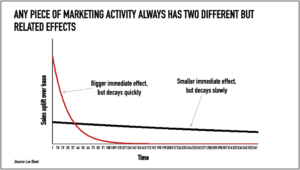Better Marketing
How do you know your marketing is working?
It’s an important question. Because if you’re spending all this money and you’re not sure of the results, then what’s the point..? You could always just – stop – and see what happens.
Rather a brave move, to be honest, and a smarter way of doing it would be to get into some marketing measurement, and carefully monitor the results.
Now before you jump into the world of clicks, likes, opening rates and visitors, because there’s a whole world of that out there, let me tell you the one, most important marketing metric of all. The only one that really counts, and if you keep this in mind across everything you do, then you won’t go far wrong.
The only marketing metric that counts…
Is that the marketing you’re doing, supports the goals of the business.
And the answer is yes, or no, it’s as simple as that. Now your goal may be to expand into new markets, increase revenue or launch a new product into your existing market – but whatever it is, that’s your ultimate litmus test.
You are not, however, going to get there immediately, so you’ll need to build a series milestones to achieve, and corresponding factors to measure, ensuring you’re on the right track. A series of smaller ‘marketing metrics’, if you will, that are steps on the road to commercial business success.
The difference between marketing metrics and business metrics
Well, there are simply too many out there to be monitoring them all. So we have to narrow the field, and focus on the metrics that will be most useful given your business, and its ultimate goals. Here’s a few things to consider before making up your mind.
Objectives
The first thing to say is that you need to make a distinction between business objectives and marketing objectives, and both should be clearly stated. Yes, marketing should help with the business objectives – that’s the big picture. But there are also many marketing objectives that are much smaller picture, and these are also important to measure.
As the business owner, you’ll be more concerned with the big picture objectives and the contribution marketing makes to them, but you should be sure whoever is doing your marketing is measuring the small picture objectives, and understands how the two relate. One way to view it is the small picture (let’s call them tactical) marketing metrics are measuring steps along the path to the big picture objective.
Let’s say your business objective is to increase the value of the business by developing a more consistent revenue stream. You’ve figured out the strategy of offering a wider range of services that your client base can use every single month, as opposed to only occasionally. Now it’s marketing’s job to help take that to market.
Your first port of call would probably be existing clients, up-selling them into the new model. This may be via email, phone calls or a webinar series.
Tactical metrics you measure: number of calls made, email opening and click-through rates, website conversion, prospect data captured, webinar attendances etc.
Bigger picture metrics: meetings secured aka Sales Qualified Leads (SQL) and ultimately, of course, signatures on the bottom line.
Next you might want to secure some new clients from outside your existing database. So you run a Google Ad campaign. Now add cost-per-click and bounce rates to the tactical metrics to help with testing a variety of different ads and landing pages, and make constant little improvements to get more people in the top of your funnel.
Your bigger picture data might now include cost of acquisition, which of course impacts directly on profitability.
Can I use tactical marketing metrics to judge marketing activity?
If you were thinking as you read the above: ‘this is partly about short-term vs long-term outcomes’ you’d be right. Most tactical metrics look at immediate response patterns, and naturally it takes longer to shift the dial on the big picture.
Does this mean you assess marketing performance just by looking at the tactical metrics? No.
Because most marketing works the big picture and small picture simultaneously. To explain, let’s take your website. In our example above, your website should now be focussed on getting visitors to enquire about your new service, and you can easily measure that. But a website serves many other purposes, and some of them are very hard to measure. For example …
Present your brand
Your website sets the tone for how people should view and feel about your business. And given they may well not be in market to buy straight away, whether and how they remember it.
What impact are you making on them? Will they tell their friends and colleagues? Do they correctly understand how you differ from the competition? Despite being hard to measure, how well you present your brand makes a huge difference to your success, and can even affect how much you charge – we’ve written more about this here.
Educate prospects
If you’re selling a complex process or service, you may need to go into a lot of detail to explain it all properly, and establish your authority in the subject matter before anyone will enquire, let alone buy. Are you managing to do that? How can you tell..? (Hint: downloadable content is one way).
Reassure, retain and upsell customers
Never take a customer for granted! They may have second thoughts, want more information, consider a competitor … your website provides the opportunity to upsell or cross sell even more, reinforce the brand, and remind them about all the benefits of your service at the same time! You can’t measure the customers who almost left you but didn’t!
Then there are the website jobs that are easier to measure:
Get people to sign up to a newsletter
Get them on your database, and you’ve got another prospect on the way to an eventual sale. Keep a record that they signed up via the website so that you can attribute any eventual sale to it.
Allow you to retarget them
This is a way to tracking a visitor to re-present your brand to them later as they visit another website, perhaps even one of your competitors.
Give prospects a second chance to buy
If a visitor doesn’t sign up straight away, do you consider that a loss? Certainly not. They might be in the early stages of consideration. If your website has given them the info they need in a persuasive manner, they will be a future customer… but it’s unlikely you’ll discover the role the website played…metrics or no metrics!
Phew! That’s just one example of a marketing channel, and the same principle applies to most others.
So there’s a good degree of judgement required in assessing whether your marketing is – in our earlier example – serving the ultimate objective of building more value by developing a consistent revenue stream. But if you’re measuring that, and it’s happening, then you’re right on target and marketing is playing its role.
Picking the most appropriate marketing metrics
Given we all live in the real world, deciding what to measure and what not to in order to figure out if your marketing is working is an important, but not simple, decision. There are two key considerations:
- Time; the most important commodity of all
What we’re talking about here, is how quickly do you expect your marketing to work?

Drop the price on Nike’s for a week, and you’ll shift more immediately – success!
If you’re in the B2B world, however, where sales cycles can take months, even years, you could halve your prices and not see the needle move for some time.
As a guide then, you should run activity, measure effectiveness and determine ROI after a period of time at least as long as your sales cycle.
And yet, this often isn’t the case. The eternal pressure for sales, sales now (!) sales yesterday (!) tends to get in the way of a measured analysis of marketing. Short-termism could easily leading you to stop a campaign that would have been successful in landing a host of new clients, just because it didn’t happen fast enough. Despite being responsible for some terrible marketing decisions, plenty of people who really should know better make this mistake.
Here’s a few frightening statistics on that front.
-
- 77% of marketers measure ROI within the first month of their campaign
- 55% of them, admitted they had a sales cycle of three months or more!
- Only 4% of marketers measure ROI for 6 months or longer
- 80% of CFOs at 400 of the world’s largest companies would sacrifice a firm’s economic value to meet this quarter’s earnings expectations!
Now that we’re into time scales, allow me to introduce you to another aspect of marketing that’s always hotly debated and discussed, despite there being a fairly definitive answer….
…. should you focus on short-term, sales activation type marketing, or long-term, brand building type marketing..?
Well the answer, dear reader, is both.
Ten years ago, esteemed researchers Les Binet and Peter Field reviewed 1,000 real life case studies gathered over decades and produced a book called ‘The Long and the Short of It: Balancing Short and Long-Term Marketing Strategies.’

The result of all this analysis confirmed that you really need both kinds marketing going on at the same time. Direct marketing to drive sales (the kind you can easily measure), and brand building marketing (the kind that’s hard to measure) to increase the effectiveness of your direct marketing.
And the split, in general, if you’re examining your budget is 60% brand marketing, and 40% direct marketing. You can buy the book here, and delve right in if you want to know more, it’s well worth the read.
This leads us nicely into the last consideration for measuring your marketing effectiveness…
2. The practicality and importance of what we can measure
If ‘brand marketing’ is so important, is there really no way to tell if it’s working..?
Well yes, if you’re a big brand you engage a research firm to find out for you, and they track measures of brand health and sentiment regularly over a period of time, but that’s expensive and most of us don’t have the luxury. Too impractical.
No, we just have to measure what we can easily measure, and live with some uncertainty. Sounds flaky but remember, big successful companies who spend millions and CAN afford to make sure it’s a good investment, keep spending those millions.
As we said above, the best approach is one eye on the small-picture tactical performance – easy thanks to Google et al – and one eye on the bigger-picture of your business progress.
In practice, how does this ‘two-speed assessment’ work? Let’s take an example: you email a beautifully presented case study to your database outlining some recent work you and your team are quite proud of. What are the objectives, and can you measure them?
Keeping your brand front of mind
Objective: A gentle reminder you’re still here, and if they need any help to get in touch.
Measurement: Unless you ask your customers what they thought of it, there’s no way to measure the brand impact.
Demonstrate expertise and positioning as highly experienced
Objective: To further convince prospects and confirm to clients that you know what you’re doing in a wide range of areas.
Measurement: Again, no easy way.
Make your team involved in the project feel proud
Objective: Staff satisfaction, staff retention, reputation as an employer of choice.
Measurement: Is there a reliable empirical way to measure an employee’s feelings? Not that we know. Use your gut! Ask them!
Tracking leads
Objective: Sales enquiries. Generally, peole set two kinds: Marketing Qualified Leads (MZL) who are people who express and interest but make a opurchase or don’t want a meeting, so you will continue to market to them. And Sales Qualified Leads (SQL), the ones ready to actively engage with your selling process.
Measurement: If you set things up, you can track both phone and digital response. SQLs are pretty easy to track through to sale (or no sale), your sales data needs to combine with your marketing data of course. But if you only get MQLs, was it a failure? No, you nurture them and they buy nine months later. Do you know it was the email that started it ball? Probably not. And if you got no leads at all, all is not lost….you got your brand in front of them and the next message has a better chance of working. (Research has found it takes an average of six brand exposures before a prospect reacts).
Commercial impact, ROI
Objective: Making sales is the ultimate objective, of course.
Measurement: Sales. Sounds easy, but to track sales back to a specific marketing activity isn’t all that easy.
The only marketing metric that counts…
Marketing measurement isn’t a simple topic. Even Google says “In the absence of perfect measurement, marketers must navigate uncertainty to make decisions that they think will drive the best future returns, based on their experience and expertise”.
Just don’t get lost. Be selective, be realistic, be patient. Bringing it all back to your business goals is the most important thing to remember. Even if you’re lost with the measurement side of things, but your revenue is still happily marching in the right direction, then that’s a pretty good indication you’re doing something right.
If that’s the case don’t make any big, bold changes, make sure your marketing is being measured and optimised so it constantly improves as you go, and you don’t need to sweat the small stuff – that’s on your marketers.
Can’t get the right marketing expertise? The Inside Out solution
If you’re thinking all this can get a bit complicated, then you’re right, which is why we’ve developed a new way for SMEs to access the senior marketing talent they need to grow their business, without paying for a full-time employee.
Because not doing any marketing just isn’t an option, and doing it badly wastes your time, and your money too. So if you’re feeling stuck and it’s all taking way too much of your time and attention, please, contact us… we’ve got a much better way.



